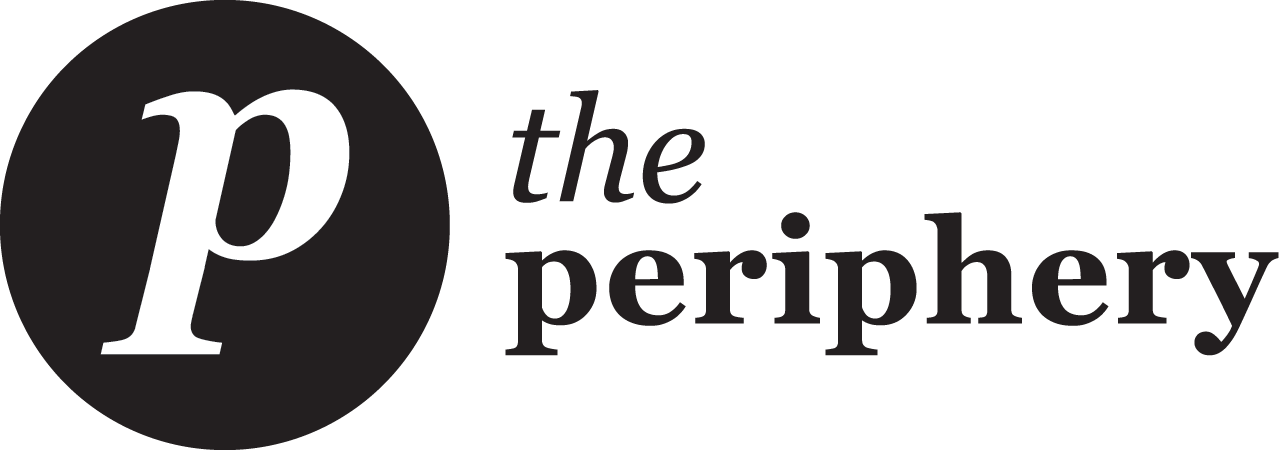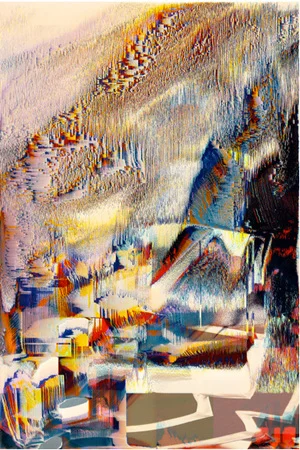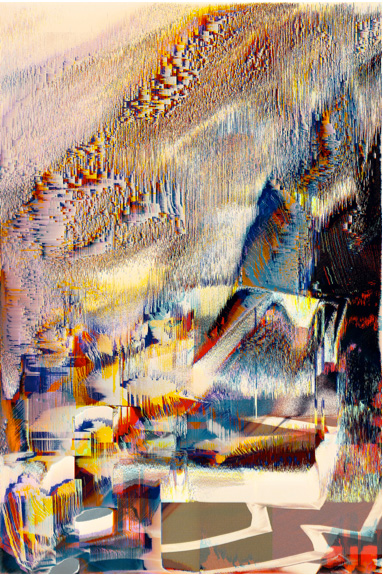Glitch IT GOOD: UNDERSTANDING THE
GLITCH ART MOVEMENT
//mallika roy
Berlin-based Hungarian artist David Szaudr, aka Pixel Noizz, from his Failed Memories series
From Swedish developer Peder Norby's Flickr documenting glitches in iOs Maps
Massachusetts-based Sabato Visconti
Canadian artist Mathieu St-Pierre, Ocean 2
what glitch art is and why it matters
The word "glitch" is already loaded with an aesthetic — highly saturated rainbow stripes and white noise chopping up an image, pixelated video streams in which the subjects' words don't match up with the audio, shimmering and twitching spots in video games. Although glitches are more often than not met with impatience or annoyance, a growing number of artists are aestheticizing errors from digital or analog sources, either by intentional manipulation or by malfunctions and corruptions like the ones we're already familiar with.
As we become more and more wrapped up in technology, glitch art has begun to be taken more seriously as a movement with a unique potential for timely cultural commentary, rather than just an aesthetic embraced by individual artists. Artists began actively connecting around this aesthetic on a larger scale as early as 2002 at the Glitch Symposium and Performance Event held in Oslo, but the medium only picked up serious momentum much more recently: showcases of glitch artists have occurred in several global cities in the past few months alone, from the UK's Tate Britain and Getty Images Gallery, to the Ukrainian Institute of Modern Art in Chicago, and, most recently, San Francisco's Dogpatch Cafe & Art Gallery (currently on view until December 12th).
Karbon, Illegal Film of Aliens. From his site: "Created & manipulated on Amiga1200's and fed through a series of scan converters, VHS formats and Wobulators to Sony Trinitron broadcast monitors. The output is then photographed with film & digital cameras."
There are all kinds of ways to create or exploit a glitch for artistic purposes; not just any computer-based art can be called glitch art (see, for example, this beautiful code-generated art which doesn’t rely on glitches at all). Some processes are much more intentional and labor-intensive than others, making the glitch manipulation itself into something of an art. Some common ways for artists to encounter their glitch include:
From Phillip Stearn's DCP Series. From his site: he corrupts "the circuitry of various Kodak DC series low-resolution digital cameras."
Tom Cabrera, image distorted using a scanner.
using analog technology that malfunctions
circuit-bending - re-wiring or altering the circuit within the device
data bending - manipulating data files by opening a file of one type in a program designed to open another file (i.e. opening a jpeg in a text application, opening a video in audio processing software, etc.)
using or creating apps that rely on an algorithm to automatically chop up and reproduce a file's foundation (i.e. Pixel Drifter)
datamoshing - intentionally distorting media through loss of data during a file compression process (i.e. streaming a video that is slow and pixelated)
z-fighting - weaving multiple competing visual layers together in a way that forms one layer (i.e. aflickering texture in a video game)
For those who are lost in the darkness or want to get more technical, feel free to google these phrases as this is just not the forum for delving into what lossy compression actually means.
Glitch art starts conversations that traditional art forms can’t really access, just by the nature of how it's created. How much do we control our technology, and how much does it control us? Can technology ever transcend the imperfection inherent in its human creators? What does it mean if we can reclaim the “errors” in our computers, phones, and cameras and repurpose them as our tools? The essence of glitch art is pretty simple: humans subject themselves to technology and exert control over it to a greater or lesser extent to produce a piece of artwork that is a product of both the creator’s intention and the device’s whims. There are themes inherent in this medium, then: morbidity and destruction next to growth and regeneration, conflicts between control and unpredictability, disassembling and re-appropriating the systems that surround us, technological chaos versus human balance — or vice versa.
Because of these inherent themes, glitch art has the potential to comment on more than just an artist’s interaction with the technology in her pocket. The conversations it catalyzes transfer easily over to our contemporary relationships to the cities we live in, and glitch art is able to explore the balance of control between us and the institutions in which we are immersed. The narrative of Detroit’s art culture that we see running through national and international media, for example, builds on many of the themes that glitch art addresses — destruction versus revitalization, human processes versus those determined for us, systemic failings versus make-shift solutions — but this narrative is severely limited since it’s perpetuated by those from outside the city. For instance, there are some definite thematic connections between Detroit ruin porn — which somehow continues to fascinate the media — and glitch art; the former is cringe-worthy in its presentation and is almost always produced by someone outside of the city, but Detroit artists could use the medium of the glitch to react to, engage with, promote or criticize similar themes in a way that is resident-centered and still part of a national and international conversation.
In her article Patchwork Hedrons, Lana Polansky explains glitch art's roots in Dada and punk ideologies with regards to the “repurposing and deliberate corruption of materials, impropriety, declarations of radicalism” and the “systemic dismantling” achieved through art; with these ideologies in mind, Detroit art communities — especially those inclusive of young people who are already equipped with technological know-how — could stand to affect the glitch art movement on the whole, as well as change the narrative of the city in outside media if they begin utilizing innovative glitch art processes.
assessing the process
There's a unique relationship between the artist and her medium in creating glitch art, one that goes beyond the interaction between an illustrator and her pen, or a painter and her canvas. Illustrations, paintings, sculptures, industrial design, gifs, textiles — these mediums require a mastery of different tools that the artist ultimately wields with a high level of control (if they are considered “good” at their medium). Since these more conventional forms of art allow for the artist to take full ownership, responsibility, and control during the art-making process, the final product is the most developed and intentional form of communication between the artist and audience. In other words, the final aesthetic almost always reigns supreme while the artist’s process is secondary. Glitch artists, on the other hand, use a medium that plays an active role in determining the final piece of art. The artist’s lack of control and the device’s unpredictability are key aspects in the production of the work; the artist hands over a part of the art-making process to the device and allows the glitch to take the reins.
Three examples of light leaks affecting photos from a 35mm film camera - an aesthetic Instagram emulates through filters
For this reason, the final aesthetic of a piece of glitch art is not the only thing that matters. In glitch art, the process of the creation of the artwork means as much as the final product, and determines what can be considered true glitch art versus art that looks glitchy. Take Instagram, for example. Instagram filters affect a user’s uploaded image with an orange or red flare across the picture, a sunny tinge to the image, a too-bright or too-dark representation of the original. These filters all emulate a glitch that occurs in film cameras. When these effects appear on photos developed from actual, real film, it means that there was a light leak in the camera that affected the exposure of the film. Inducing camera glitches manually in order to produce photos subjected to the whim of the camera itself definitely falls under the umbrella of glitch art. Meanwhile, there are over 200 million Instagram users who have the capability of making a boring picture a little more interesting with the click of a button that mimics light leaks from an interaction between a manual camera and its lens. So although the aesthetic of an image produced by an Instagram user might actually be similar to a photo developed through hacking the film exposure process or light sensor, only one of these uses a process that demands a level of innovation, intention, and commitment to the artist’s camera. While the person tinkering with the camera reclaims the device’s errors and comments on the balance of control between the artist and the tool, the Instagram user remains a slave to technology and therefore makes no contribution in terms of glitch art.
Before & after: an image I uploaded to a glitch-it-yourself website next to three iterations of the image generated by the site.
Similarly, we as the audience can look at any given piece with a glitchy aesthetic and give ourselves over to the beautiful lines, eye-moving flow, stark contrast, and poetic movement in the piece, only to find out that it was generated through an app or site like this. If an artist uploads a random, unappealing image that has no meaning to them, and it rearranges the pixels, adds noise, chops it up, and spits it out according to either a glitch or a genius algorithm determined by someone else, then the maker of the site or facilitator of the glitch effect should get the credit, not the "artist” who uploaded the image. The question of how an artist is putting the "glitch" in "glitch art" matters for us to understand their level of interaction and intention with the final product, since the final piece's glitchiness doesn't quite relay that information to us. As glitch artist Daniel Temkin explains:
“How visually glitchy the results look depends much on the initial image and is not necessarily important to the piece. However, as new work is built … perhaps the glitch itself will become less important as a visual clue that it builds on this history of experiments in human/machine interaction.”
So the process of the artist differentiates what glitch art is and what it isn’t. Once an artist has utilized their tool of choice — a faulty computer algorithm, a tampered-with camera, software used to open an incompatible file type — with a level of intention and interaction, how can we decide if it’s good glitch art? Destruction versus regeneration, chaos versus control, and other themes discussed in the previous section attach themselves to the medium just by way of the processes used to create the artwork. If there is a foundation of themes already connected to glitch artists’ work solely by nature of it being glitch art, what does a piece of innovative glitch art look like?
finding the narrative
A piece of glitch art with a unique and developed narrative beyond the default concepts that drive the medium as a whole becomes very valuable because it helps push the boundaries of what we can expect from the movement as a whole. There are all kinds of possibilities here. Plummer Fernandez uses 3D printing to produce sculptures created from glitched images of everyday objects, commenting on the way our vessels reflect and connect all cultures; Tom Cabrera strategically employs scanner glitches to alter body anatomy and architectural forms, in order to “transform what is known to address the unknown”; Way Spurr-Chen developed a Twitter bot called Pixel Sorter that interacts with users (and even exchanges glitched images with other Twitter bots), the implications of which could be the subject of an essay on its own — a human creates a robot that develops its own social media network of over 1500 followers by predictably glitching photos submitted by human and robot users alike.
From Berlin-based Hungarian artist David Szaudr's Failed Memories series, in which the subjects' faces are obscured through his own doing or through his glitch art app Touch.GL
One narrative that a handful of artists have explored through glitch art is the corruption of memory in an age of technology. Berlin-based Hungarian artist David Szaudr, also known as Pixel Noizz, has an ongoing series entitled Failed Memories in which he affects the faces in photo portraits, through intentional manipulation of individual pixels and corrupted algorithms that disassemble the portraits over a length of time. This strategic erosion of photo portraits comments on the passing of time as it affects our understanding of memories and attempts to visualize the memory process as images that were once clear in our minds inevitably disintegrate.
From Kon Trubkovich's Leap Second, a series of large-scale paintings of his mother recreated from one second of a home video.
Kon Trubkovich's exploration of one second of a home video called Leap Second dives into this arena as well. Currently based in Brooklyn, he paints paused film stills of his mother from one second of a home video documenting his family’s final party in the U.S.S.R. before their immigration to the United States. For one thing, this introduces the medium of painting into the discussion of glitch art. The process of recreating television white noise through oil on linen takes the electronically-captured moment entirely out of its context and subjects it to Trubkovich’s human touch, allowing him to both regain control of the moment as well as to revel in the loss of imagery distorted by film that he is now unable to access. This series also gives Trubkovich permission to explore in excruciating depth just one second of a period of total transition for his family, showing the psychological power that technology holds over us as it becomes the only source through which we can revisit our past.
From Mathieu St-Pierre's Melted Ice Cream series, created with an editing program called Sony Vegas.
The subjects in Trubkovich’s and Szaudr’s work aren’t entirely visually abstracted — the viewer is able to glean details to a greater or lesser extent about each piece’s subject, through the glitched glimpse of an expression on a face or details in clothing. Canadian artist Mathieu St-Pierre’s Melting Ice Cream series, on the other hand, often completely abstracts his original subject in favor of a reimagined version of the memory. In an interview with Hot ‘N’ Gold Magazine, he explains his use of HD videos of his wife that he experimented with through an editing program to create vibrant landscapes with no discernible human features. These images, full of life and joy, comment on the visual associations that might replace or trigger actual memories; rather than focusing on the void created by the complete distortion of memory, he creates a beautiful new narrative from these memories that stands completely on its own, removed from the boundaries of its original source.
Szaudr, Trubkovich, and St-Pierre all use the glitch process and aesthetic to explore the creation and maintenance of memories. This is a powerful use of the medium that pushes the usual narrative attached to any old glitch art. When we capture memories through electronic devices, are those moments impenetrable from the erosion of the human mind? What happens when the technology we've entrusted with our most meaningful memories fails us? When we document experiences with technology of the moment, and later revisit these crudely-rendered experiences, are we remembering the pixels or the event itself — is this what memories of the millennial generation will look like? These are just a few examples of the kinds of meaningful narratives that can be evoked through different manipulations of glitch art processes. It takes real innovation within any medium to unearth probing questions in the minds of viewers; artists like these help forge broader notions of the possibilities of glitch art and push us forward into new philosophical territory through their work.
shaping the movement’s direction
We have the chance to actively shape the direction of what may very well become a significant period of art included in history books down the line; glitch art can comment on our increasing reliance on technology in a specific and relevant way that goes beyond the capability of conventional art forms. Artists are mapping the glitch aesthetic onto furniture, street art, fashion, textiles, and more. We’ve got to know how to be an effective audience (and, for some of us, an effective contributor) to the glitch art movement as the aesthetic starts to appear in public spaces, art galleries and museums; we need to look critically at glitch art in all its forms, to engage with it and judge it, to decide if we are annoyed or inspired by different claims in the glitch art arena, and to make the call for ourselves if a piece has meaning or not.
Cities, then, have an important role as the art movement progresses. Many cities across the world are already playing their part, providing outlets to access glitch art beyond computer screens. Detroit and other cities whose representation in the media leaves residents’ voices out of the picture have a stake in investing in this medium; Detroit galleries and artist collectives should work to strategically foster a glitch art culture in the city, whether through skill-sharing, public showcases, or simply providing feedback on the art movement as a whole. By experimenting with glitch processes, Detroit artists and others could potentially repurpose some of the narrow existing narratives of their cities and gain a prominent positive national and international voice through the glitch art movement as it progresses.
//Mallika Roy is a co-founder of The Periphery.















